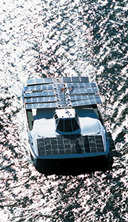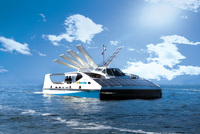Solar-Powered Ferries to Sail Hong Kong Harbor - VIDEO STORY
HONG KONG - October 14, 2009: Hong Kong waters will soon be home to four new solar-powered hybrid ferries being built by a local shipyard using a design and expertise provided by an Australian company called Solar Sailor. The vessels are being purchased by the Hong Kong Jockey Club as part of a HK$350 million (US$45 million) drive to make the city more environmentally conscious.
Click PLAY to watch video
In 1996, Australian physician and sailing enthusiast Robert Dane was watching a solar boat race, when he noticed that the solar-panelled vessels had trouble as soon as the wind picked up.
“They either had to take their panels down or tie them flat; otherwise they were unseaworthy,” he recalls. “So, I’m thinking, ‘we can do sailing boats: how would you create a solar sailing boat?’” It wasn’t long before he came across a solution inspired by nature.
 |
“I was reading that insects, which are the most successful species on the planet, initially crawled on the earth and evolved wings, first using them as solar collectors, then later to fly. As soon as I read that I thought, ‘Well, boats can evolve wings and use them as solar collectors and use them to sail, which is a lot easier than flying.’”
Mr Dane went on to leave his medical practice and founded Solar Sailor, which came up with a solar-powered hybrid ferry. It is now plying the waters of Sydney Harbour, primarily using solar and wind power. The unique design makes use of moveable rigid sails covered with solar collectors, which charge batteries that run on an electric motor. The result is a ferry that operates with at least 30 per cent less fuel and releases substantially less carbon dioxide.
On the Greens
Hong Kong waters will soon be home to four more solar-powered hybrid
ferries being built by a local shipyard using Solar Sailor’s design
and expertise. The Hong Kong Jockey Club purchased the vessels as part of a
US$45 million drive to make the city more environmentally conscious, and to
prove that green technology makes good business sense.
Three of the catamaran ferries will use solar panels, and a fourth will be outfitted with the unique sails. They will be put to work ferrying golfers to the Jockey Club’s public golf course on Kau Sai Chau Island – already home to the world’s first solar-powered golf carts. Club officials say the new technology is worth the investment.
“We really would like people to think of us as more of an enabler. We see a technology that’s thriving. But purely from a commercial standpoint, someone has to take a first step. And this is where we believe we have a role to play as far as the Hong Kong community is concerned,” says William Yiu, Executive Director, Charities at The Hong Kong Jockey Club.
Mr Dane agrees, pointing out that Solar Sailor’s technology is competing with “the incumbent industry, which has had 100 years to build up economies of scale. And so hybrid electric solar ferries have got to come in over five to 10 years, and be as good or better than the existing technology. Companies like the Hong Kong Jockey Club that show leadership and invest in this sort of technology really help get the economies of scale up.”
Setting Sail
Solar Sailor is already finding that working in Hong Kong has cut costs
compared to building them from its home base in Australia. Local
shipbuilder Leung Wan Kee is assembling the ferries on the Chinese
mainland, and another Hong Kong company will service the vessels once they
are in operation.
“We’ve been looking at better battery companies on the mainland. The resin infusion technology is available here, and the quality is excellent,” Mr Dane says. “We’re a global company, and we want to take the best from around the world and incorporate it into our systems to get the best solutions. Here in Hong Kong, we’ve met a lot of good companies and good suppliers.”
Hong Kong is also opening doors for lower-cost components that will ultimately drive down the price for future hybrid craft. Hong Kong is a natural place to test solar technology, since maritime traffic is a major source of pollution in one of the world’s busiest harbours.
“If we can make it work in Hong Kong, we can make it work anywhere. People might look at Sydney and say, ‘Hey, it’s sunny and windy and everything’s great there.’ But the technology is applicable everywhere,” Mr Dane adds.
That optimism is shared by the Jockey Club’s Mr Yiu, who expects the public and commercial sectors to get on board once the vessels are up and running later this year.
“If one is willing to tackle conservation and environmental issues today, your investment in dollars and cents will pay off big time, not only in a financial aspect but also from a social responsibility angle. I hope the projects we’re working on will demonstrate to people that this is worthwhile.”
For more information about the Solar Sailor visit www.solarsailor.com.



